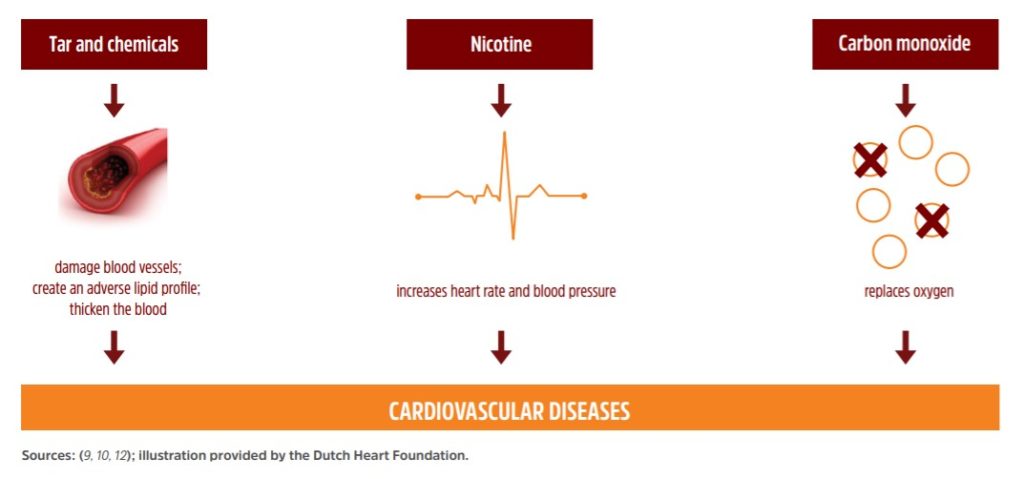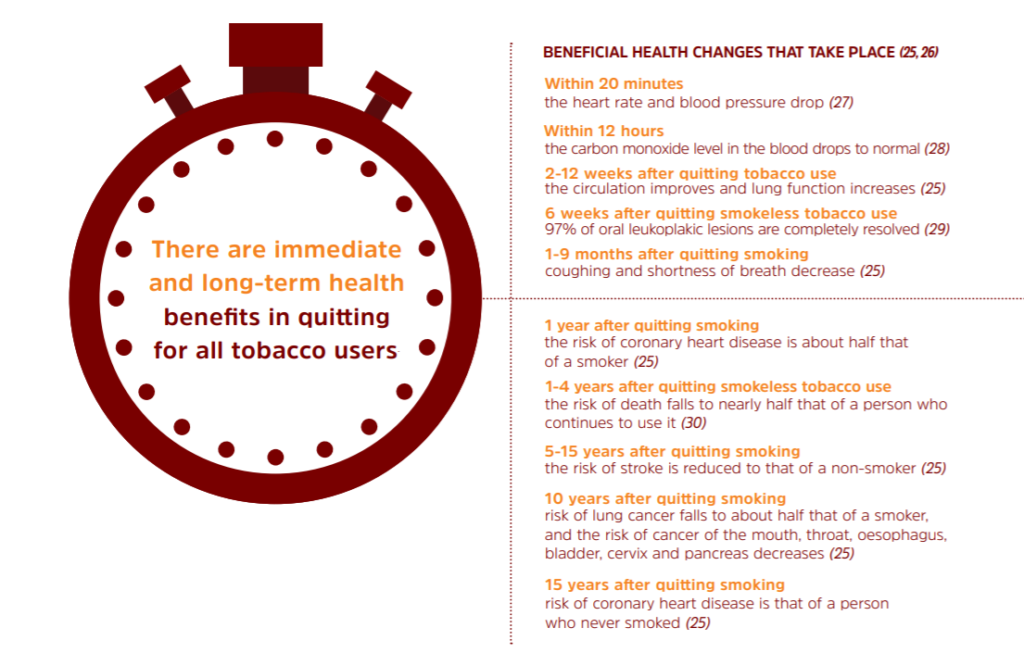3M
people die from tobacco-induced heart disease every year
Tobacco is the second leading behavioural risk factor for cardiovascular disease deaths.
3 million people die every year from heart disease attributable to tobacco use and exposure to second-hand smoke.
There are immediate and long-term health benefits to quitting tobacco.
E-cigarettes: A New Threat to Cardiovascular Health
The WHF Policy Brief on E-cigarettes lays out the negative impacts of e-cigarettes on people’s cardiovascular health and highlights the need for stricter regulation and greater oversight of these harmful products. It provides evidence-based, practical guidance that can be adapted to local contexts.
Download the Policy BriefTobacco kills more than eight million people every year, which means that nearly 22,000 people die every day from tobacco use or exposure to second-hand smoke.
Tobacco use and exposure to second-hand smoke are among the leading causes of cardiovascular disease globally, contributing to approximately 17% of all CVD deaths – the equivalent of more than three million people every year. Despite the known harms of tobacco to heart health, and the availability of solutions to reduce tobacco-related death and disease, public awareness of the link between tobacco and heart disease remains low.
While tobacco consumption is levelling off and even decreasing in some countries, worldwide more people are smoking, and smokers are smoking more cigarettes. Almost 80% of the 1 billion smokers around the world live in average and lower income countries where the burden of illness and death associated with tobacco is much greater. These populations also tend to be the targets of intensive tobacco industry marketing.
people die from tobacco-induced heart disease every year
Second-hand smoke exposure causes 1.3 million deaths every year
of the world's 1.3 billion tobacco users live in low- and middle-income countries
The cardiovascular risks attributable to tobacco smoking increase with the amount of tobacco smoked and the years of having smoked. Although there is a strong dose/response relationship between the amount of tobacco smoked per day and cardiovascular risk, the relationship is not linear. The risk is substantially increased by exposure even to low levels of tobacco smoke, as with exposure to second-hand smoke. In fact, smoking only one cigarette per day incurs about half the risk of developing coronary heart disease and stroke incurred by smoking 20 cigarettes per day. Chewing tobacco more than doubles the risk of heart attack.
The impact of tobacco smoke is not confined solely to smokers. Cardiovascular disease is by far the greatest cause of death associated with second-hand smoke, which increases the risk of CVD by approximately 25-30%. Around 45% of the estimated 1.3 worldwide deaths caused by second-hand smoke are attributed to ischaemic heart disease. Frequent exposure to tobacco smoke, whether in the workplace or home, has been found to nearly double the risk of having a heart attack.
Tobacco smoke contains over 7,000 chemicals and acts in a number of ways to cause CVD. Its use, whether by smoking or chewing, damages blood vessels, raises blood pressure and lowers exercise tolerance. Tobacco also decreases the amount of oxygen that the blood can carry to the heart and increases the risk of blood clots, which can in turn lead to a heart attack or stroke.

Just a few cigarettes a day, occasional smoking and exposure to second-hand smoke can all increase the risk of heart disease. But if tobacco users take immediate action and quit, the risk of heart disease will decrease by 50% after just one year of not smoking. 15 years after quitting, the risk of suffering from a coronary disease becomes equivalent to that of a non-smoker.

Tobacco control is a key element for reducing heart disease. Governments can help tobacco users quit by increasing tax on tobacco products, enforcing bans on tobacco advertising and offering services to help people give up tobacco. Smoking bans have been found to decrease the rates of heart attacks, and evidence indicates that smoke-free laws are one of the most cost-effective ways to prevent heart attacks.
Many governments are making progress in the fight against tobacco. In 2019, five billion people were living in countries that have introduced smoking bans, graphic warnings on packaging and other effective tobacco control measures – four times more people than a decade earlier.
Governments can loosen the death grip of heart disease on their populations by implementing measures that are in line with the WHO Framework Convention on Tobacco Control (FCTC) including raising taxes on tobacco products, making them less affordable, and enacting smoke-free legislation.
The tobacco industry continues to aggressively promote the use of tobacco products and to conceal the dangers of tobacco use, but we are fighting back to help prevent this ongoing devastation.
In line with the World Health Organization’s World No Tobacco Day campaign, the World Heart Federation encourages everyone everywhere to adopt a healthier lifestyle. A healthy diet is essential to the prevention and reduction of heart disease and many of its associated risk factors. The daily consumption of nutritious foods such as fruits, vegetables, legumes, […]
Tobacco
The Indonesian Heart Foundation successfully implemented the “Sekolah Tanpa Advertising Rokok” (School with No Cigarette Advertisement) – STAR initiative from October 2022 to February 2023 in five cities across Indonesia, with the support of the Swedish Heart-Lung Foundation and the World Heart Federation through the World Heart Grants programme. The initiative aimed to educate junior […]
Tobacco
The World Heart Federation (WHF) officially endorsed a statement issued by the Southeast Asia Tobacco Control Alliance (SEATCA) to support the Ministry of Health of Malaysia on its Generational End Game (GEG) policy proposal. WHF believes that the GEG policy constitutes a sensible strategy to protect future generations from lifelong addiction as well as chronic […]
Tobacco
Tobacco kills over 8 million individuals every year, including 1.2 million non-smokers as a result of second-hand exposure. The effects of tobacco on health, as well as its links to a wide range of diseases, are well-established. As a leading cause of heart disease, tobacco contributes to approximately 17% of all cardiovascular disease deaths and […]
Tobacco